I'm a total salmon lover – seriously, show me a fresh piece of salmon and I'll show you ten different ways to cook it! But this Sinigang na Salmon Belly sa Kamias recipe? It's my ultimate comfort food hack. Instead of the usual pork or beef sinigang, I use salmon belly which not only cooks faster, but also adds this incredible richness to the soup.
The fatty belly pieces become so tender they practically dissolve in your mouth, while the kamias gives that unique tang that you just can't get from regular tamarind. It's the kind of dish that makes you want to curl up with a bowl of rice and just let all your worries float away in that steamy, soul-warming broth.
Jump to:

Why You'll Love This Recipe
- Healthier Alternative: Rich in omega-3 fatty acids and protein from salmon belly
- Quick & Easy: Ready in just 35 minutes
- Versatile: Customizable with different vegetables
- Authentic Taste: Traditional souring agent (kamias) provides unique flavor
- Budget-Friendly: Makes use of affordable vegetables
- Comforting: Perfect for cold weather or when feeling under the weather
Ingredients
The ingredients in this Sinigang na Salmon Belly sa Kamias create a perfect balance of flavors and textures while offering excellent nutrition. Salmon belly provides heart-healthy omega-3 fats and a rich, melt-in-your-mouth quality that absorbs the tangy broth beautifully.
Kamias (bilimbi fruit) delivers the signature sourness that defines sinigang while offering a brighter, more refreshing tang than traditional tamarind. The carefully selected vegetables — crisp radish, tender long beans, soft eggplant, slippery okra, and fresh bok choy — each add unique textures and nutrients while absorbing the flavorful broth.
Fish sauce enhances the umami depth without overpowering the delicate salmon, while banana chili adds just enough warmth to bring everything together in this nourishing, comforting soup.

For the Soup Base
- 6 cups water (tubig)
- 1 tablespoon fish sauce (patis)
- 2 cups kamias (bilimbi fruit), halved
- 1 small onion (sibuyas), peeled and quartered
- 2 medium tomatoes (kamatis), quartered
- 1 banana chili (siling pang-sigang), sliced lengthwise
Main Ingredients
- 1 pound salmon belly (tiyan ng salmon), scaled, cleaned, and cut into 2-inch pieces
- 1 cup white radish (labanos), peeled and cut into 1-inch chunks
- 1 cup long beans (sitaw), cut into 3-inch lengths
- 1 medium eggplant (talong), cut into 1-inch chunks
- 4 pieces okra (okra), trimmed
- 1 bunch bok choy (pechay), washed and separated into leaves
- Salt (asin) to taste
- Optional: 1 teaspoon white sugar to balance acidity if needed
Equipment
- Large Pot (Kaldero): A 6-8 quart heavy-bottomed pot is ideal for even cooking and preventing burning. The size ensures vegetables have room to cook properly without overcrowding.
- Sharp Chef's Knife (Matalas na kutsilyo): Essential for cleanly cutting salmon and preparing vegetables with precision, which affects cooking time and texture.
- Sturdy Cutting Board (Sangkalan): Preferably with a juice groove to catch liquids when preparing salmon and vegetables.
- Measuring Cups and Spoons (Panukat): For accurate measurements, especially important for balancing the sour elements.
- Fish Scaler (Pangkayod): For removing any remaining scales from the salmon belly if your fishmonger hasn't completely cleaned it.
- Large Soup Ladle (Sandok): Allows you to serve the soup with equal portions of vegetables, salmon, and broth.
- Spider Strainer or Slotted Spoon: For skimming any scum that rises to the surface during cooking.
- Colander (Salaan): For washing vegetables thoroughly.
- Soup Bowls (Mangkok): Deep bowls are traditional for serving sinigang.
- Small Serving Bowls: For optional condiments like extra fish sauce, chopped chilies, or calamansi.
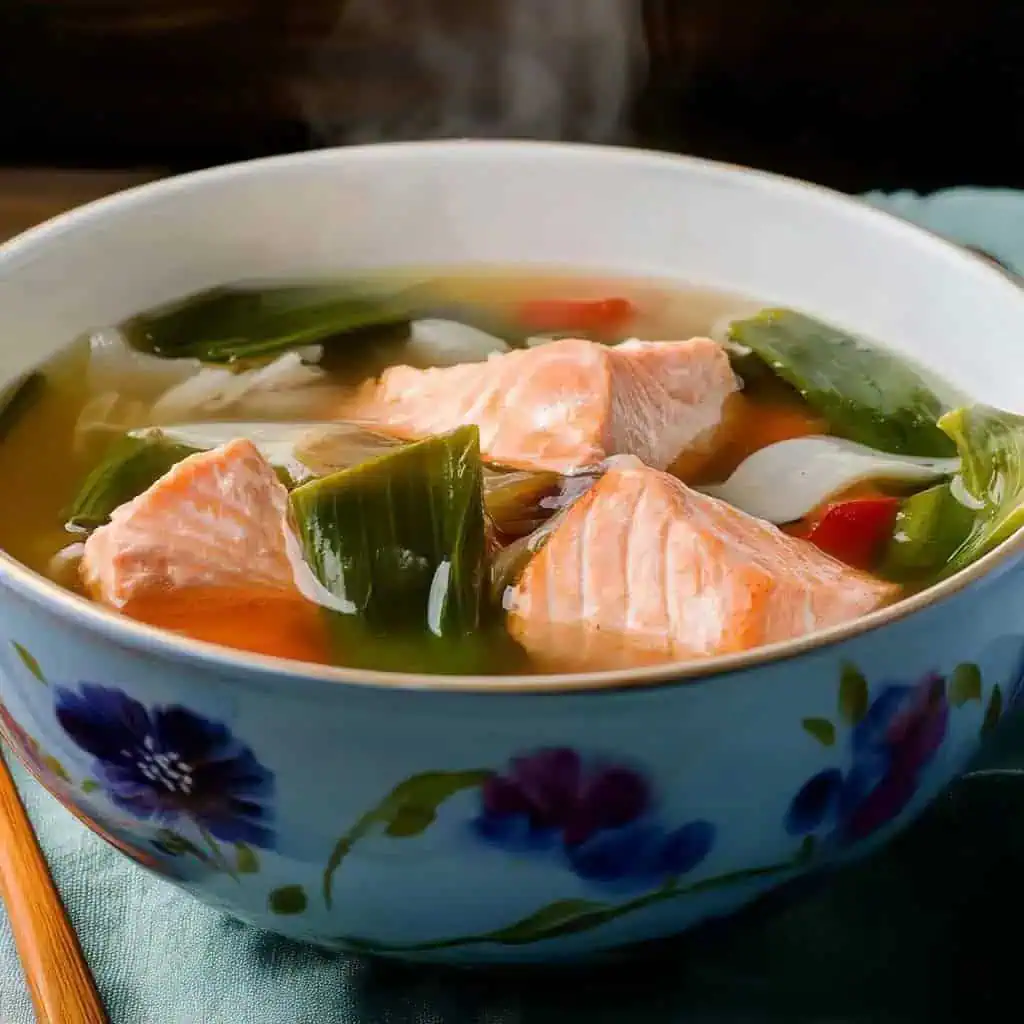
How To Make
- Bring 6 cups of water to a gentle boil over medium heat in a large pot. Once boiling, add fish sauce, kamias, quartered onion, quartered tomatoes, and banana chili. Simmer for 1-2 minutes to release the sour flavor from the kamias.
- Add the white radish chunks and cook for 1-2 minutes until slightly softened. Add the long beans and cook for another 2-3 minutes.
- Add the eggplant chunks and trimmed okra, continuing to cook everything together.
- After the vegetables have cooked for a few minutes, gently add the bok choy and let it cook for 1-2 minutes until just wilted.
- Finally, add the salmon belly pieces and cook for 7-10 minutes, or until the salmon easily flakes with a fork and has changed from translucent to opaque pink. Be careful not to overcook.
- Taste the soup and add salt as needed. The broth should have a pleasant balance of sour and savory flavors.
- Serve hot with steamed rice on the side and optional condiments like fish sauce and chopped bird's eye chilies.

Tips from Lola's Kitchen
- Always add salmon last to prevent it from breaking apart during the cooking process
- Keep vegetables slightly crisp by adding them in order of hardness—root vegetables first, leafy greens last
- Use the freshest salmon possible for best flavor and texture
- Balance the sourness with a tiny pinch of sugar if the kamias makes the broth too tart
- Skim any foam that rises to the surface for a clearer, more beautiful broth
- Don't stir too vigorously once salmon is added to maintain the integrity of the fish pieces
- Taste as you go and adjust the sourness with more kamias if needed
Substitutions
- No kamias? Use 3-4 tablespoons of tamarind paste (sampalok) or ¼ cup calamansi juice
- Salmon alternatives include milkfish belly (bangus), sea bass, or even firm white fish like cod
- Replace bok choy with water spinach (kangkong), regular spinach, or mustard greens
- Instead of long beans use regular green beans or snap peas
- Radish substitutes include turnips or jicama for a similar crunchy texture
- Out of banana chili? Use jalapeño or simply omit if you prefer less heat
Troubleshooting
- Soup too sour? Add a teaspoon of sugar or more water to dilute
- Salmon falling apart? You likely overcooked it—next time, add it later in the process or reduce heat
- Cloudy broth? Be sure to skim the surface regularly as scum appears
- Vegetables unevenly cooked? Remember to add them in stages according to cooking time
- Not sour enough? Add more kamias or a splash of calamansi juice
- Too fishy smell? A splash of rice vinegar can help neutralize strong fish odors
Storage & Reheating
- Refrigerate in an airtight container for up to 3 days
- Freeze for up to 2 months by storing the broth and salmon separately
- Stovetop reheating: Warm gently over low heat until just heated through (about 5 minutes)
- Microwave method: Heat in 1-minute intervals, stirring between each, until just warmed (2-3 minutes total)
- Add fresh herbs like cilantro or green onions after reheating for brightness
- Consider removing the salmon before reheating and adding it back at the end to prevent overcooking
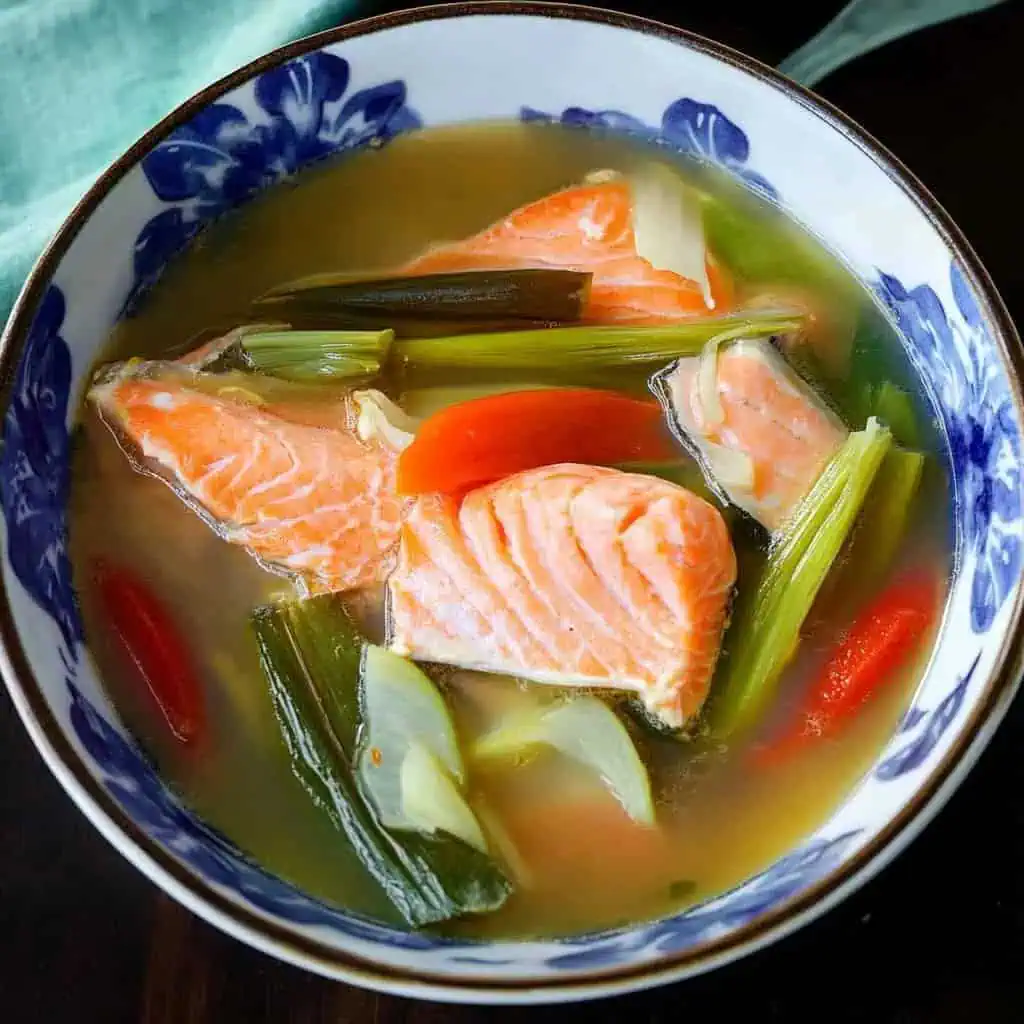
FAQ
Can I use frozen salmon belly?
Yes, but thaw it completely in the refrigerator overnight and pat it dry before adding to the soup.
How do I know when the salmon is perfectly cooked?
The salmon should flake easily with a fork but still be moist. It should be opaque throughout with no translucent center.
Is this recipe keto-friendly?
Yes, especially if you limit or omit the starchier vegetables like radish. The salmon provides healthy fats while the broth is naturally low in carbs.
Can I make this ahead for a party?
Prepare the broth and vegetables ahead of time, but add the salmon fresh when reheating to serve. This prevents overcooking the fish.
What makes kamias different from tamarind?
Kamias has a brighter, more citrusy sourness compared to tamarind's deeper, more complex sour flavor. Kamias also creates a lighter-colored broth.
Can I add other vegetables?
Absolutely! Try adding taro, sweet potato, or even pumpkin for heartier versions. Just adjust cooking times accordingly.
Does this soup reheat well?
Yes, but reheat gently and consider removing the salmon pieces first, then adding them back at the end to prevent them from becoming tough.
Is this suitable for pregnant women?
Yes, salmon is excellent during pregnancy due to its omega-3 content, but ensure the fish is thoroughly cooked.
Related
Looking for other recipes like this? Try these:
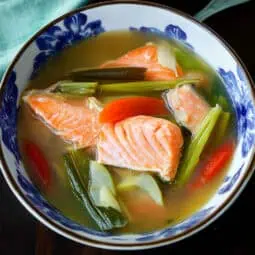
Sinigang na Salmon Belly sa Kamias (Filipino Salmon Sour Soup)
Equipment
- Large pot (kaldero) For cooking the soup
- Sharp knife [Matalas na kutsilyo] For preparing vegetables and fish
- Cutting board (Sangkalan) For safe food preparation
- Measuring cups and spoons (Panukat) For accurate measurements
- Soup ladle (sandok) For serving
- Fish scaler (pangkayod) For scaling the salmon if needed
- Colander (salaan) For washing vegetables
Ingredients
For the Soup Base
- 6 cups water tubig
- 1 tablespoon fish sauce patis
- 2 cups kamias
- 1 small onion sibuyas, peeled and quartered
- 2 medium tomatoes kamatis, quartered
- 1 banana chili siling pang-sigang
Main Ingredients
- 1 pound salmon belly tiyan ng salmon, scaled and cut into pieces
- 1 cup white radish labanos, peeled and chunked
- 1 cup long beans sitaw, cut into 3-inch lengths
- 1 eggplant talong, chunked
- 4 pieces okra okra, trimmed
- 1 bunch bok choy pechay
- Salt asin to taste
Instructions
- Begin by bringing 6 cups of water to a gentle boil over medium heat in a large pot. Once boiling, add 1 tablespoon of fish sauce, 2 cups of kamias, the quartered onion, quartered tomatoes, and banana chili. Let this simmer for 1-2 minutes to release the sour flavor from the kamias.
- Next, add the chunks of white radish and cook for 1-2 minutes until they start to soften. Add the cut long beans and let them cook for another 2-3 minutes. Now add the eggplant chunks and trimmed okra, continuing to cook everything together.
- After the vegetables have cooked for a few minutes, gently add the bok choy and let it cook for 1-2 minutes until just wilted. Finally, add the salmon belly pieces to the pot. Cook for 7-10 minutes, or until the salmon easily flakes with a fork and has changed from translucent to opaque pink. Be careful not to overcook the salmon as it can fall apart.
- Taste the soup and add salt as needed. The broth should be pleasantly sour and savory. Serve your sinigang hot in bowls with steamed rice on the side. For extra flavor, serve with patis (fish sauce) and chopped bird's eye chilies as condiments.
- Note: If any scum rises to the surface while cooking, simply skim it off with a spoon for a clearer broth. The total cooking time should be about 20 minutes, and the soup should be steaming hot (around 185-190°F) when served.
Tips from Lola's Kitchen
- Always add salmon last to prevent it from breaking apart
- Don't overcook the vegetables to maintain nutrients and texture
- Use very fresh salmon for best results
- If kamias is too sour, balance with a pinch of sugar
- Remove scum that rises to the surface for clearer broth
Nutrition
The Story Behind Sinigang na Salmon Belly sa Kamias
Sinigang, a cornerstone of Filipino cuisine, has been warming hearts and homes across the Philippines for generations. While traditionally made with pork or beef, the evolution of this beloved dish led to the creation of Sinigang na Salmon Belly sa Kamias, a coastal adaptation that perfectly marries the bounty of the sea with the Philippines' love for sour soups.
Coastal communities in the Philippines, particularly in regions where salmon was introduced through trade and modern aquaculture, began experimenting with this premium fish in their local dishes. The natural oils and rich texture of salmon belly proved to be an inspired choice for sinigang, as the fatty meat releases its flavors into the broth while remaining remarkably tender through the cooking process.
The use of kamias (bilimbi fruit) instead of the more common sampalok (tamarind) showcases the ingenuity of Filipino cooks in working with local ingredients. Kamias trees, found in many Filipino backyards, produce fruit year-round, making this souring agent readily available for home cooks. The distinct tartness of kamias pairs exceptionally well with salmon, cutting through its richness while adding a bright, clean flavor that tamarind can't quite match.
This modern interpretation of sinigang reflects the ongoing evolution of Filipino cuisine, where traditional cooking methods meet contemporary ingredients. The dish has gained popularity not only for its incredible flavor but also for its health benefits – combining the omega-3 rich salmon with a variety of nutritious vegetables creates a complete meal that's both satisfying and nourishing.
Today, Sinigang na Salmon Belly sa Kamias has found its way onto restaurant menus and family dinner tables across the Philippines and beyond, beloved by those seeking a lighter yet equally satisfying version of the classic sour soup. It's a testament to how Filipino cuisine continues to adapt and innovate while maintaining its authentic flavors and cooking traditions.
Whether enjoyed on a rainy afternoon, as a comforting dinner, or as a hangover cure (as many Filipinos swear by!), this dish represents the perfect balance of traditional Filipino flavors with modern culinary preferences. The combination of tender salmon belly, sour broth, and fresh vegetables continues to captivate food lovers, making it a cherished addition to the ever-expanding repertoire of Filipino sinigang varieties.
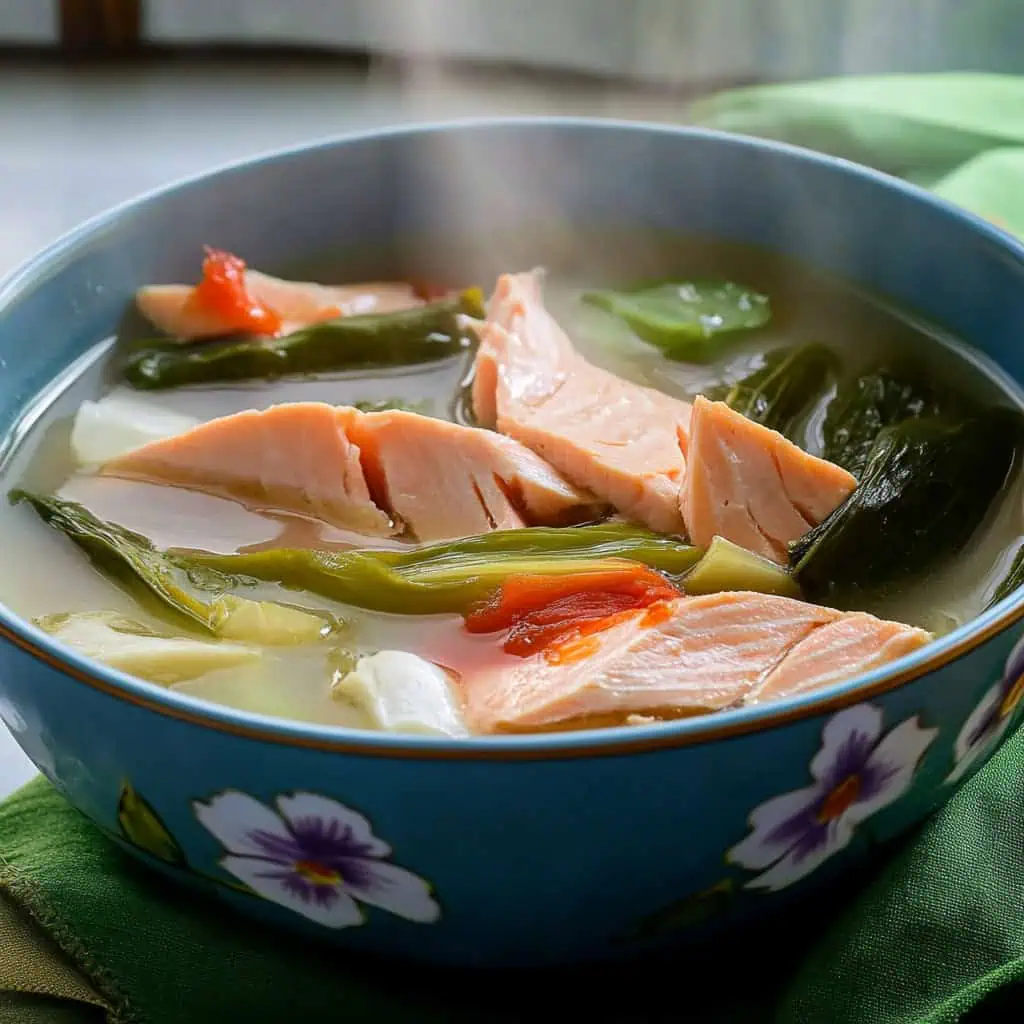





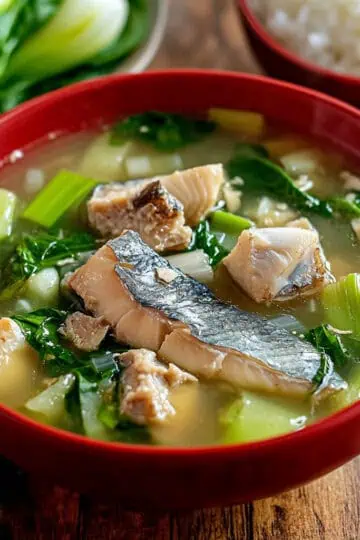
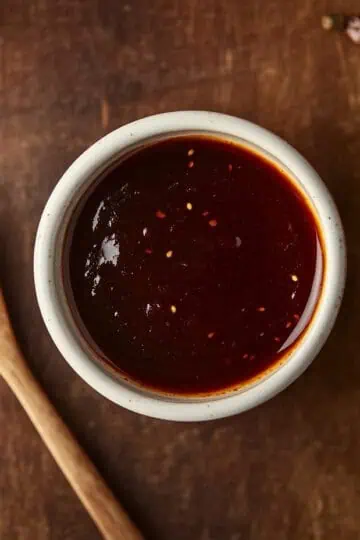
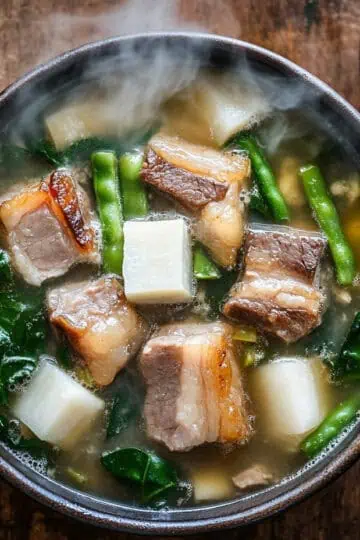
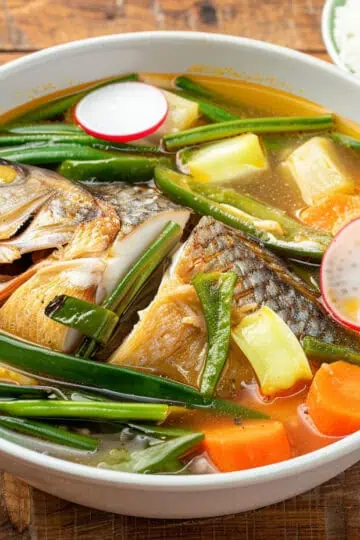
Comments
No Comments